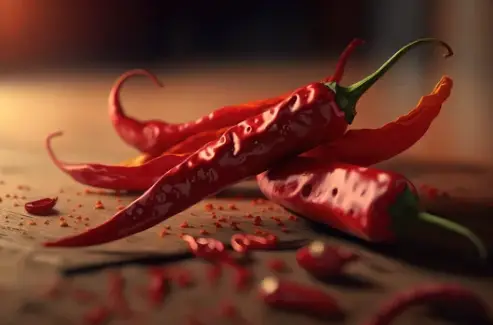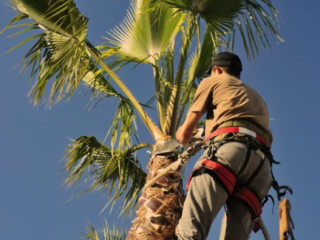Peppers have been a staple in cuisines around the world, adding flavor, color, and that unmistakable kick to dishes.
From mild and subtle to fiery and intense, peppers come in various shapes and sizes, each carrying a unique level of spiciness.
However, in the realm of chili peppers, one particular contender reigns supreme in terms of heat—the spiciest pepper in the world.
In this blog post, we’ll embark on a journey to explore the top contenders for this fiery title and reveal the ultimate champion that sets taste buds ablaze.
Top Spiciest Pepper in The World List
The Scoville Scale
Before diving into the quest for the world’s spiciest pepper, it’s crucial to understand the Scoville scale.
Developed by pharmacist Wilbur Scoville in 1912, this scale measures the capsaicin concentration in peppers, determining their spiciness.
Capsaicin is the compound responsible for the burning sensation we experience when consuming spicy foods.
The higher the Scoville rating, the hotter the pepper.
| Pepper | Scoville Heat Units (SHU) |
|---|---|
| Bell Pepper | 0 SHU |
| Poblano Pepper | 1,000 – 2,000 SHU |
| Jalapeño Pepper | 2,500 – 8,000 SHU |
| Serrano Pepper | 10,000 – 23,000 SHU |
| Cayenne Pepper | 30,000 – 50,000 SHU |
| Thai Pepper | 50,000 – 100,000 SHU |
| Habanero Pepper | 100,000 – 350,000 SHU |
| Scotch Bonnet Pepper | 100,000 – 350,000 SHU |
| Ghost Pepper (Bhut Jolokia) | 800,000 – 1,041,427 SHU |
| 7 Pot Douglah | 800,000 – 1,853,936 SHU |
| Trinidad Moruga Scorpion | 1,200,000 – 2,009,231 SHU |
| Carolina Reaper | 1,400,000 – 2,200,000 SHU |
Please note that Scoville ratings can vary slightly depending on growing conditions and pepper samples tested.
1) Carolina Reaper
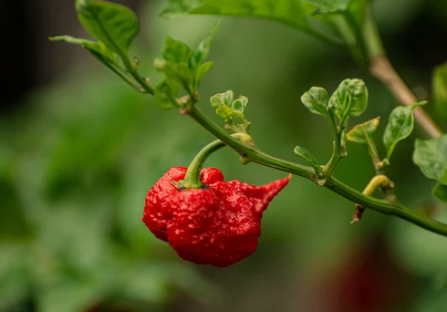
In 2013, the Carolina Reaper emerged as the hottest pepper in the world, taking the crown from the Trinidad Moruga Scorpion.
Developed by Ed Currie of the PuckerButt Pepper Company in South Carolina, this pepper consistently tops the Scoville scale. It boasts an average rating of over 1.5 million Scoville Heat Units (SHU), with some individual peppers reaching a mind-boggling 2.2 million SHU.
The Carolina Reaper showcases a distinctive wrinkled appearance and an intense fruity flavor with an earth-shattering burn.
2) Trinidad Moruga Scorpion
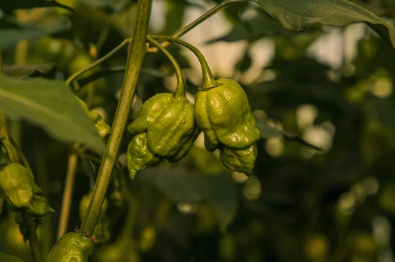
Before its reign was usurped by the Carolina Reaper, the Trinidad Moruga Scorpion held the title of the world’s hottest pepper.
Originating from Trinidad and Tobago, this pepper delivers an astonishing heat level, averaging around 1.2 million SHU.
The Trinidad Moruga Scorpion exhibits a bumpy surface and a fruity, floral flavor profile, leaving an enduring, searing sensation on the palate.
3) Bhut Jolokia Pepper
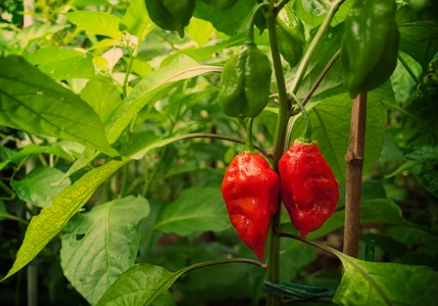
Often referred to as the Ghost Pepper, the Bhut Jolokia hails from the northeastern region of India.
This pepper gained international recognition for its fiery heat, ranking among the spiciest peppers on the Scoville scale.
With an average rating of around 1 million SHU, the Bhut Jolokia presents a distinct smoky flavor that adds complexity to its intense burn.
It has found its way into various culinary applications, including hot sauces, snacks, and even defense sprays.
4) Pepper X

Introduced to the world by Ed Currie, the creator of the Carolina Reaper, Pepper X is another contender for the title of the world’s spiciest pepper.
While precise SHU measurements are yet to be determined, it is believed to surpass the Carolina Reaper in terms of heat.
This pepper carries a fruity and slightly sweet flavor, backed by an unforgiving burn that can leave even the most seasoned spice enthusiasts gasping for relief.
5) Dragon’s Breath Pepper
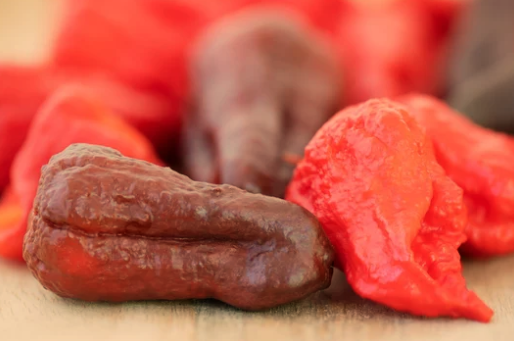
Known for its menacing name, the Dragon’s Breath pepper is an intriguing entry in the world of super-hot peppers.
Developed by Mike Smith, this pepper claims to be hotter than the Carolina Reaper. However, limited information is available regarding its precise Scoville rating.
What sets the Dragon’s Breath apart is its alleged ability to induce potentially dangerous effects if ingested, making it more of a novelty than a culinary ingredient.
6) Naga Viper

The Naga Viper pepper, originating from the United Kingdom, gained attention in 2010 for its extreme heat.
Created by chili farmer Gerald Fowler, it is a crossbreed of three super-hot peppers: the Bhut Jolokia, the Trinidad Moruga Scorpion, and the Naga Morich.
With an average Scoville rating of around 1.3 million SHU, the Naga Viper delivers an intense and lingering burn.
Its flavor profile combines fruity and floral notes, making it a favorite among those seeking a fiery culinary experience.
7) 7 Pot Douglah
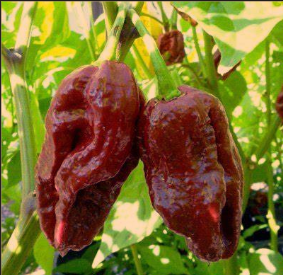
The 7 Pot Douglah, also known as the Chocolate 7 Pot, is a pepper originating from Trinidad and Tobago.
Renowned for its deep brown color, this pepper packs a punch in terms of heat.
With a Scoville rating ranging from 800,000 to 1.8 million SHU, the 7 Pot Douglah is a true scorcher.
It offers a complex flavor profile with hints of chocolate, nuttiness, and a fiery undertone that sets it apart from other super-hot peppers.
8) Scorpion Butch T
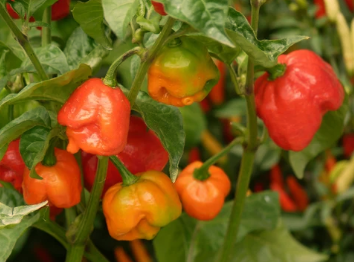
Another contender in the race for the spiciest pepper is the Scorpion Butch T.
Developed by Butch Taylor, a chili grower from the United States, this pepper held the title of the world’s hottest pepper in 2011, surpassing the previous champion, the Trinidad Moruga Scorpion.
It boasts an average Scoville rating of around 1.4 million SHU, delivering a searing heat that lingers on the palate.
The Scorpion Butch T exhibits a distinct scorpion-like tail, hence its name, and its flavor profile combines fruity and smoky notes.
The Great Pepper Debate
Determining the absolute spiciest pepper is a topic of heated debate among chili enthusiasts.
The Scoville scale provides a relative measure, but variations in growing conditions, genetics, and testing methods can yield different results.
Also, new hybrid varieties are constantly being developed, pushing the boundaries of heat.
Therefore, it’s essential to approach the concept of the spiciest pepper with an understanding that rankings can change over time as new peppers emerge.
Tips for Handling and Enjoying Spicy Peppers
When it comes to handling and consuming spicy peppers, it’s essential to exercise caution to avoid any unpleasant experiences. Here are some tips to help you navigate the world of spiciness:
Start Mild
If you’re new to spicy peppers, begin with milder varieties such as jalapeños or serranos, and gradually work your way up to hotter peppers.
Use Gloves
When handling extremely hot peppers, such as the Carolina Reaper or Bhut Jolokia, wearing gloves can protect your skin from the potent capsaicin oils that can cause irritation.
Remove Seeds and Membranes
The seeds and white membranes inside peppers contain a significant amount of capsaicin. Removing them can reduce the overall heat level of the pepper.
Build Flavor Gradually
Instead of overwhelming a dish with an excessive amount of spiciness, add small amounts of spicy peppers and taste as you go, gradually building the heat according to your preference.
Balance with Cooling Agents:
If a pepper proves too hot to handle, balance the spiciness by pairing it with cooling agents like dairy products (milk, yogurt), citrus (lime or lemon juice), or sweet ingredients (honey, sugar).
Enjoy in Moderation:
Spicy peppers can provide an exciting culinary experience, but remember that moderation is key. Respect your tolerance and listen to your body’s signals.
Conclusion
The quest for the world’s spiciest pepper is an ongoing adventure that showcases the passion and innovation of chili pepper enthusiasts worldwide.
While the Carolina Reaper has been widely recognized as the reigning champion in recent years, new contenders like Pepper X and Dragon’s Breath continue to push the boundaries of spiciness.
Whether you’re a culinary adventurer seeking a fiery thrill or simply fascinated by the complex world of peppers, exploring the range of spicy peppers can be an exhilarating journey for your taste buds.
Remember, when handling and consuming these peppers, exercise caution, and have a glass of milk nearby—just in case you need to cool down from the searing heat.

